Signal transduction pathways
1/45
There's no tags or description
Looks like no tags are added yet.
Name | Mastery | Learn | Test | Matching | Spaced |
|---|
No study sessions yet.
46 Terms
Why Do We Need To Know How Signal Transduction Pathways Work?
• Signal transduction pathways play important roles in the body, both in physiologic and pathologic states
• Normal physiology - endocrine signaling, neurotransmitter signaling
• Pharmacology - most pharmacological agents function by either stimulating (agonists) or inhibiting (antagonists) signal transduction pathways
• Cancer - many cancers have mutations in components of signal transduction pathways that produce a constant proliferative signal that is the hallmark of tumorigenesis
extracellular signals transmit information?
from one cell to another
For extracellular signals
- they are required for cells to?
They are required for cells to survive, grow, and divide
What does an extracellular signals tell the cell?
They also tell a cell when to differentiate and when to die
Examples of extracellular signaling molecules?
• Insulin
• Epidermal Growth Factor (EGF)
• Adrenaline (Epinephrine)
Types of extracellular signaling? (5)
- direct contact
- hormone (endocrine)
- paracrine
- autocrine
direct contact
signaling producing cell must physically come in contact with target cells
hormone (endocrine)
Signal-producing cells (endocrine cells) release signaling molecules (hormones) that act on distant target cells
Paracrine
Signal-producing cells release signaling molecules that act on proximal target cells
Autocrine
Signal-producing cell is the target cell
Signal transduction
- Signal transduction pathways mediate the sensing and processing
external stimuli
Signal transduction
- The signal begins at the cell surface and is converted into
of a functional response inside the cell
Signal transduction
- They detect, amplify, and integrate external signals to generate responses such as changes in ?
- in enzyme activity, gene expression, or ion-channel activity
Signal transduction
- cell sense extracellular signals through ?
receptors
signal transduction
- cell surface receptors are embedded in the plasma membrane of the?
of the cell and face the extracellular space
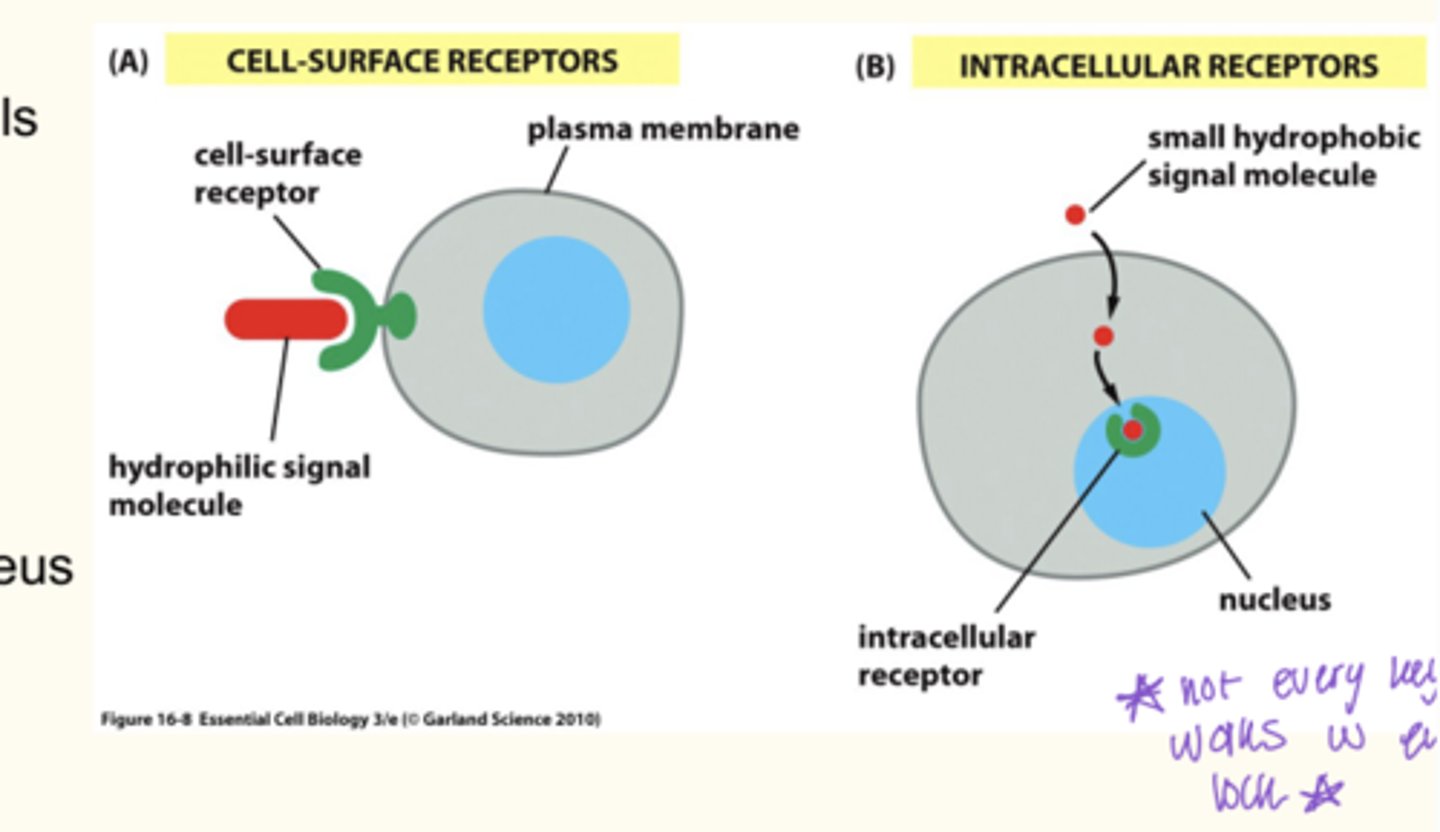
Intracellular receptors can be found in the ?
in the cytoplasm or nucleus inside the cell
Receptors are
Molecule that receives signals from the extracellular environment
Ligand
Molecule that selectively binds to a receptor
Four major families of cell surface receptors
1. Ion-channel receptors
2. Enzyme-linked receptors
3. Cytokine receptors
4. G-protein-coupled receptors
ion channel coupled receptors
- found on ?
electrically excitable cells - neurons, muscle cells
ion channel coupled receptors
- transduce a ?
a chemical signal into an electrical signal
ion channel cr
- when the receptor is open?
- ions enter or exit the cell along their electrochemical gradients
ion channels cr
- response? (time)
fast milliseconds
ion channel- coupled
- nicotinic acetylcho receptor
- binding of acetylcholine ( or nicotine) causes?
conformational change in the receptor

on channel- coupled
- nicotinic acetylcho receptor
- this conformational change results in?
This conformational change results in the formation of a pore that allows for Na+ ions to enter the cell, allowing for propagation of action potentials
Terminated of signal:
ion channel coupled receptors
- ligand is ?
- ex?
Ligand is degraded by specific digestive enzymes (protease)
- Ach (ligand) is degraded by Acetyl (protease)
Enzyme coupled receptors
- time?
- Slow response (hours)
• Only one trans-membrane domain
• Largest class of enzyme coupled receptors:
• Receptor tyrosine kinases (RTKs)
• Most extracellular signals for growth, survival, and proliferation act through RTKs
• Initiates a signaling cascade via phosphorylation events
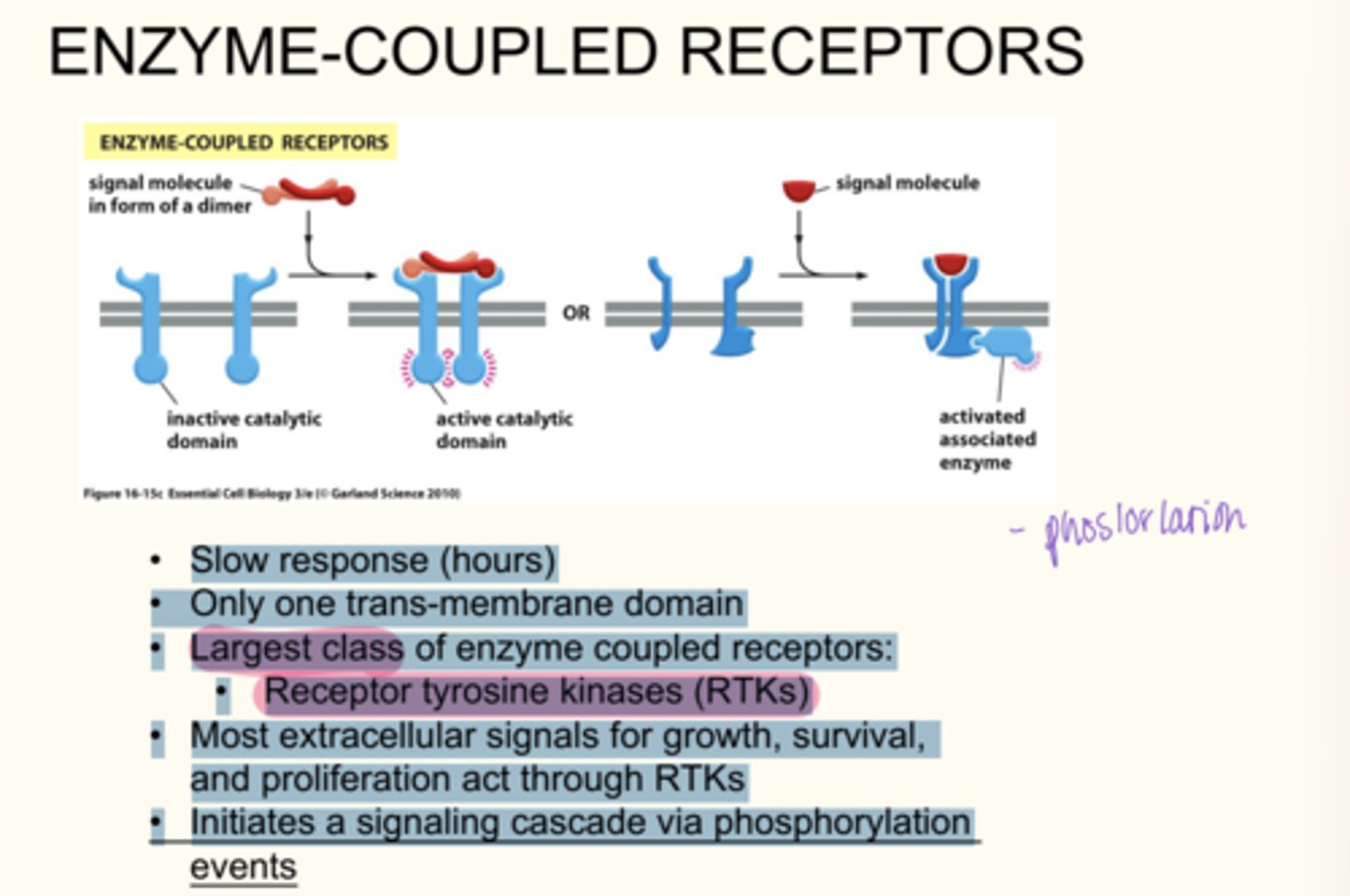
Activation of RTKs Required Dimerization
Upon binding of signaling molecule (ligand), inactive RTK monomers come together to form a dimer • Contact between the two adjacent intracellular receptor tails activates the kinase function, and each receptor unit phosphorylates the other on specific tyrosines
• These phosphorylated tyrosines can serve as docking sites for "adaptor proteins" that will relay the signal inside the cell

MUTATIONS IN RTKS CAN LEAD TO UNREGULATED CELL PROLIFERATION
EGFR: Receptor for Epidermal Growth Factor (EGF)
• Stimulates cell growth, proliferation, and differentiation
• Activating mutations of the EGF pathway are common in some forms of cancer
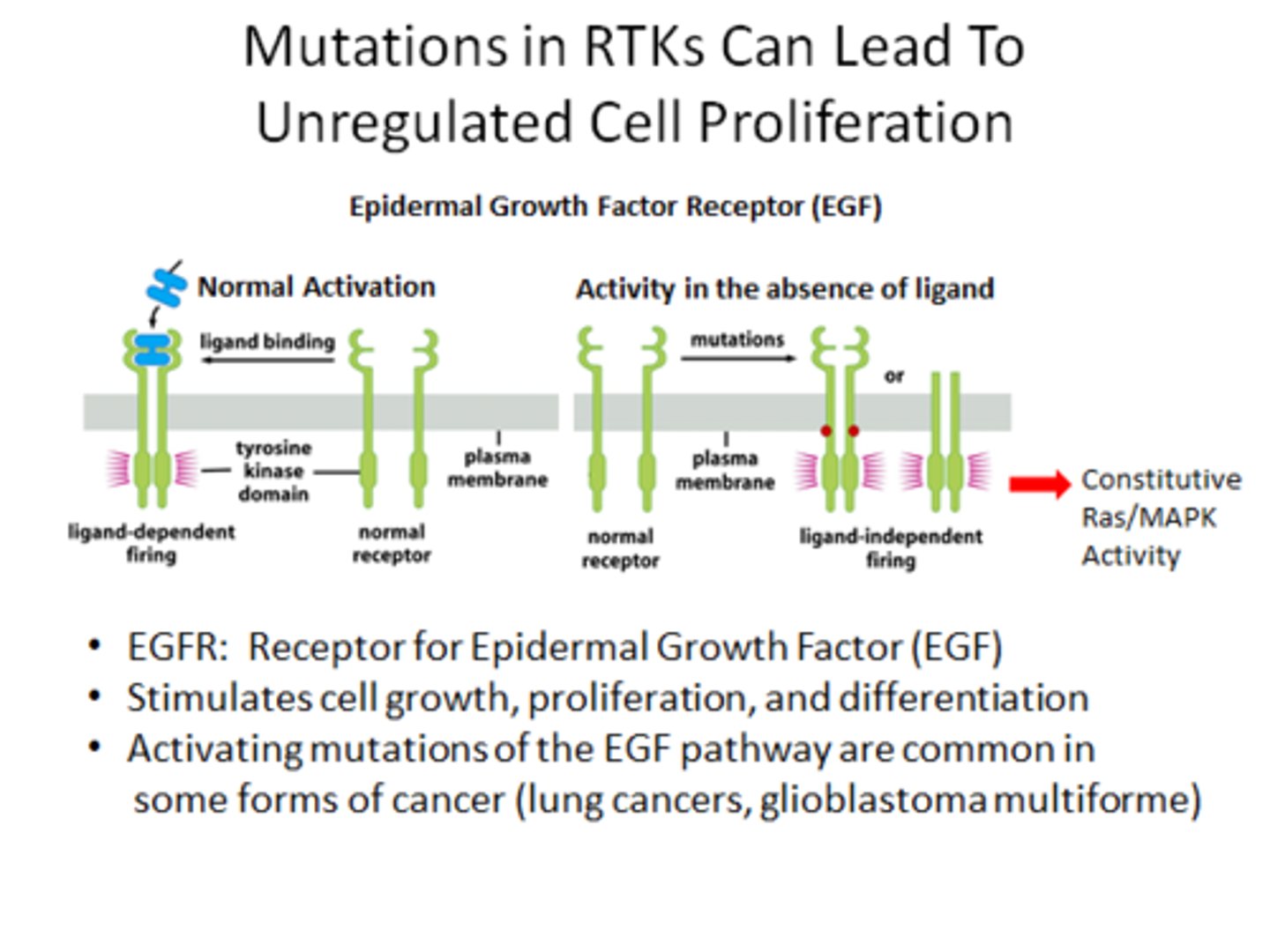
Enzyme coupled receptors

Termination of signal:
- enzyme coupled receptors
Phosphorylation activates proteins (turns on)
• Dephosphorylation deactivates (turns off)
• Dephosphorylation occurs via phosphatases

Cytokine receptor
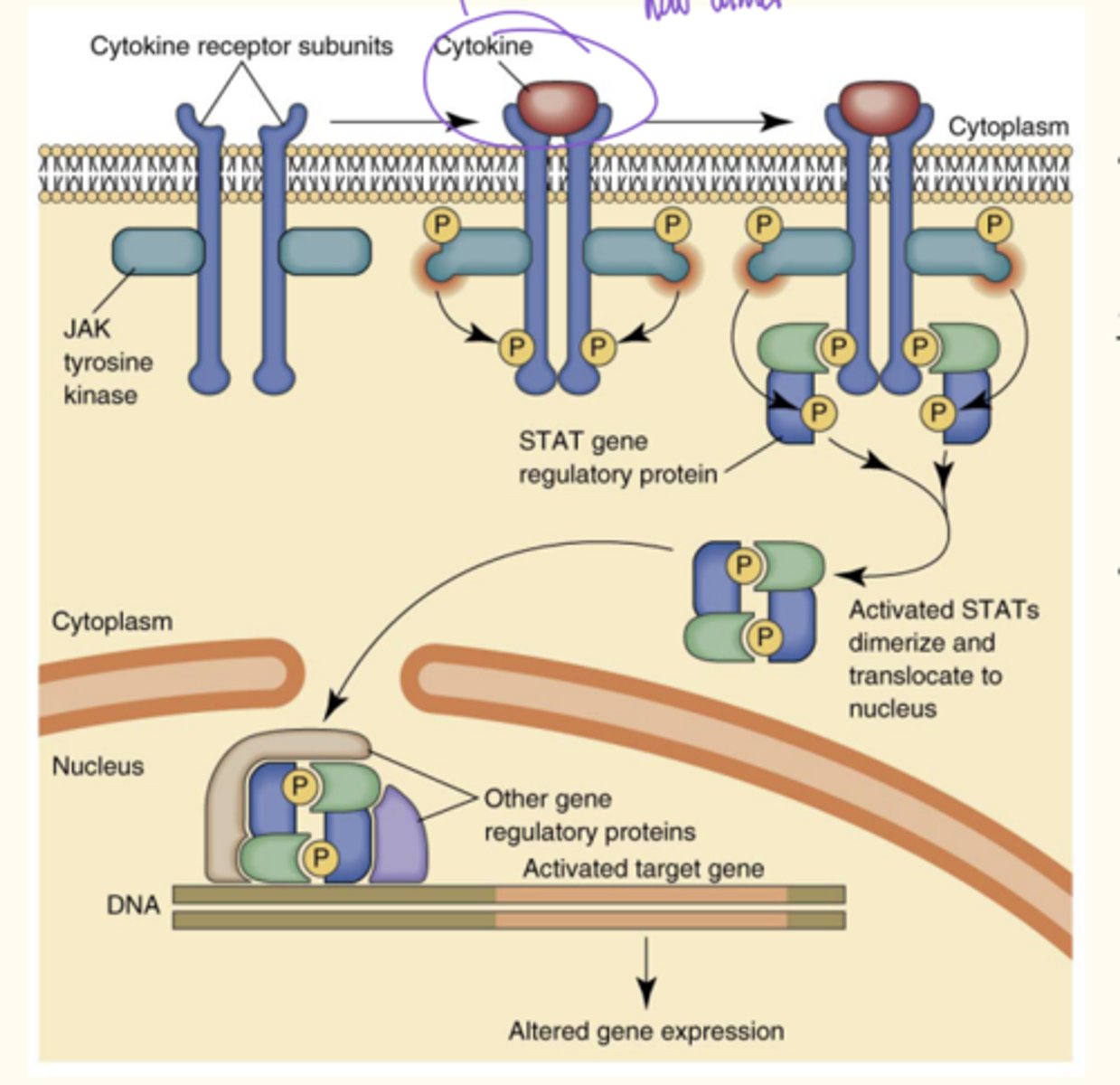
Cytokine receptor
Begins similarly to enzyme-linked receptor signaling:
1) Binding of cytokine causes dimerization of receptor
2) Associated tyrosine kinase (JAK) is then activated
3) JAK phosphorylates the intracellular tail of the receptor at specific tyrosine sites
4) The phosphorylated tyrosines serve as docking sites for SH2 domain-containing proteins (STATs)
5) STATs are phosphorylated, dimerize, translocate to nucleus, and serve as transcriptional regulators for the expression of specific genes • "JAK-STAT signaling pathway"
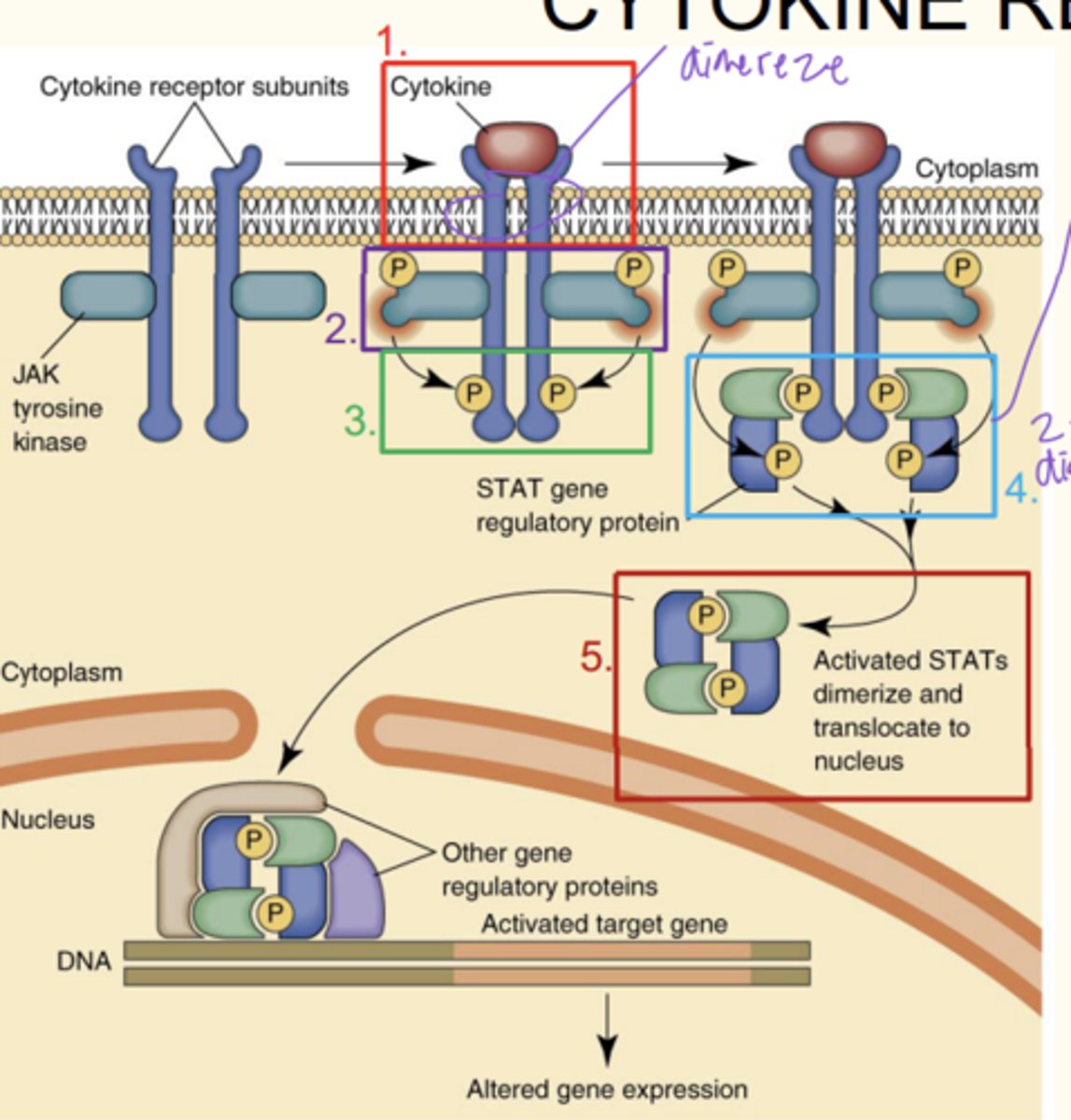
G-protein coupled receptors
- Seven-pass trans-membrane receptor
• Largest family of cell surface receptors
• Half of all known drugs work through GPCRs
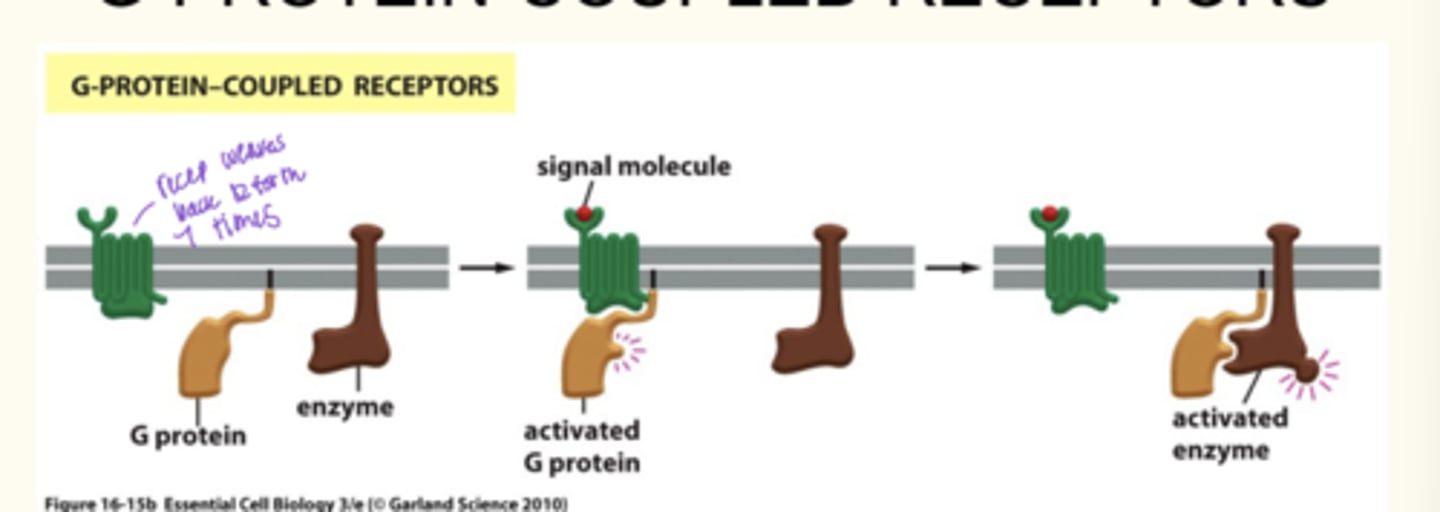
G protein bind ? they are?
Guanine nucleotides (GDP and GTP)
- They are heterotrimeric in structure - alpha, beta, and gamma subunits
• They bind to GPCRs (G-protein coupled receptors)
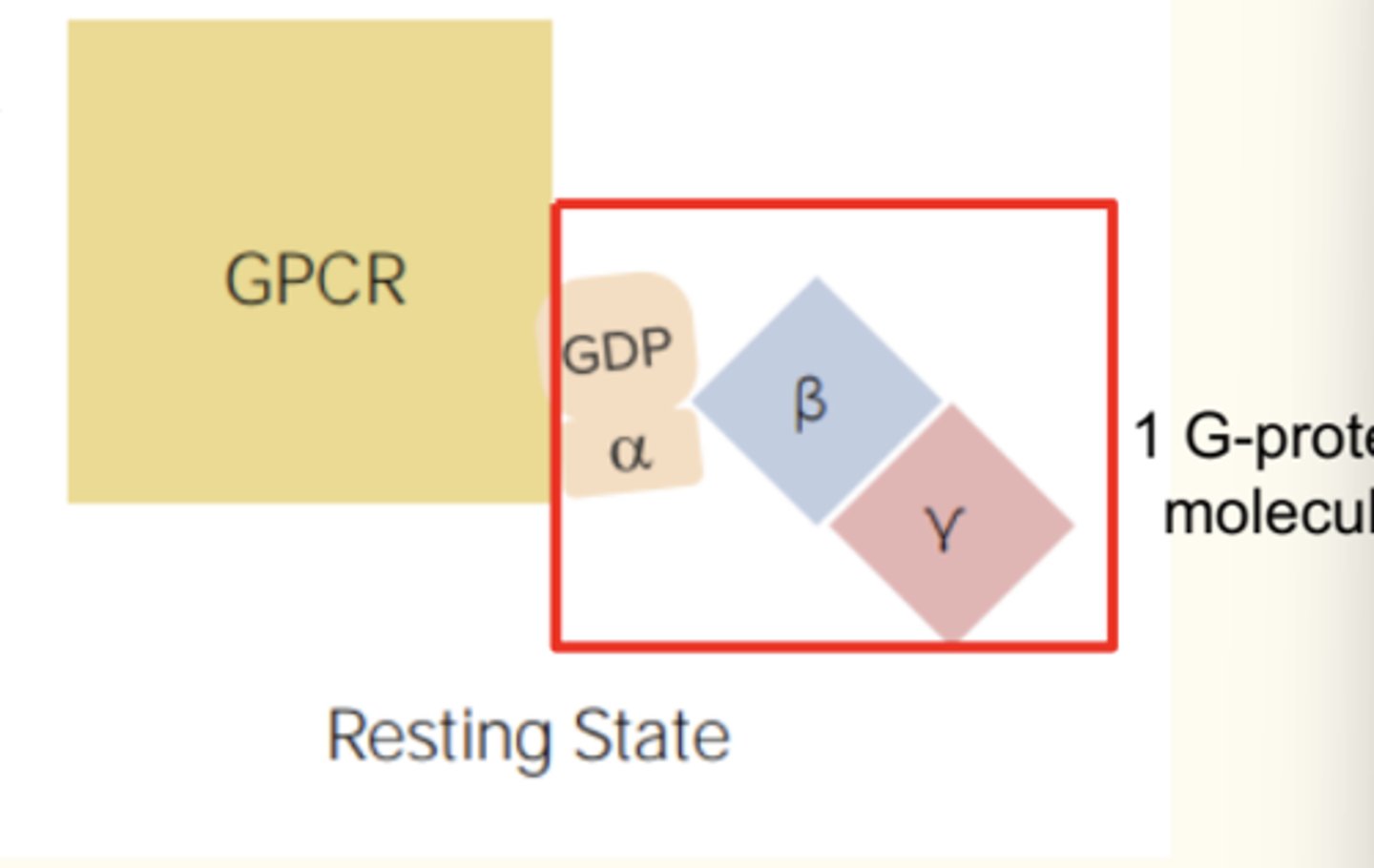
G proteins alter their shape due to?
binding to GPCR
The α subunit binds to GTP/GDP, possesses GTPase activity
- When bound to GTP?
- When bound to GDP?
GTP= On (active)
GDP= Off
Ligand binds to its binding site on the external portion of the receptor induced ?
a conformational

This causes phosphorylation of the GDP bound to the alpha subunit becomes ?
alpha‒GTP (activated G protein)
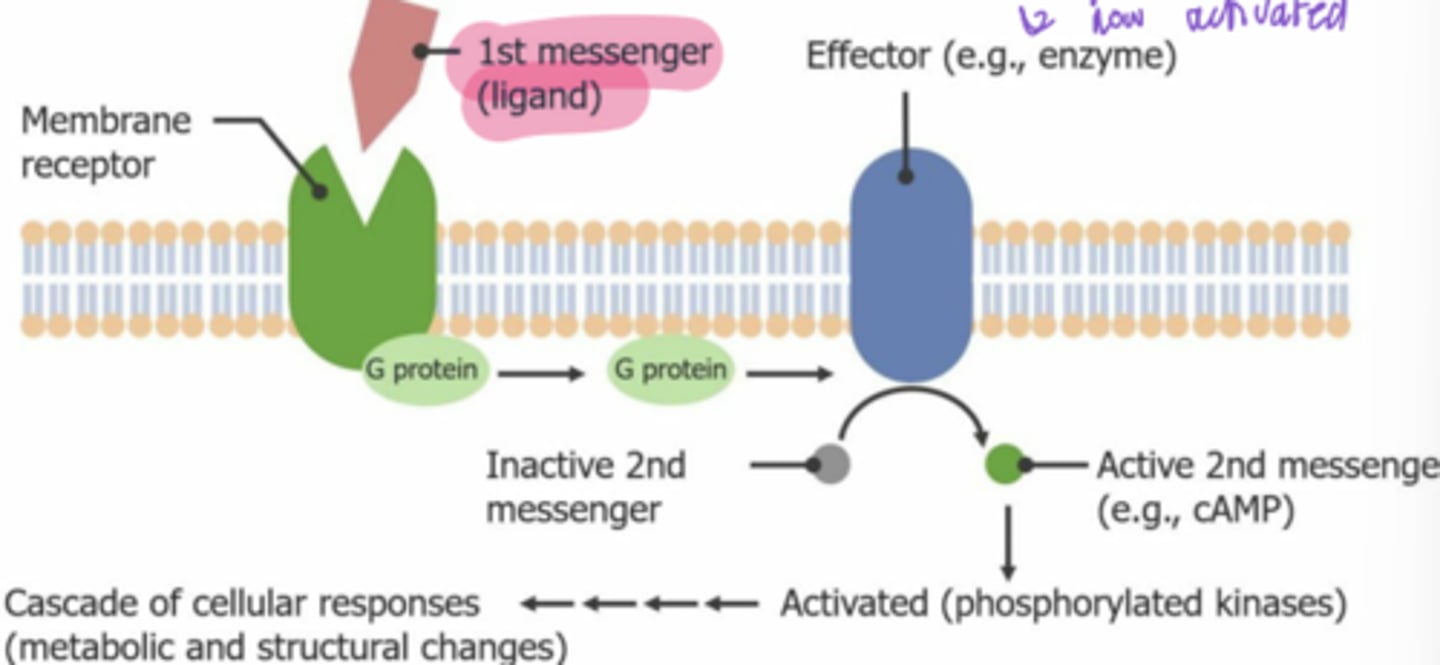
G protein coupled receptor
- Alpha‒GTP separates from the beta and gamma subunit phosphorylates the ?
- The effector protein can then activate second messengers, intermediaries that can ?
- the next protein in the signaling cascade known as the effector protein
- propagate and amplify signals in the cell
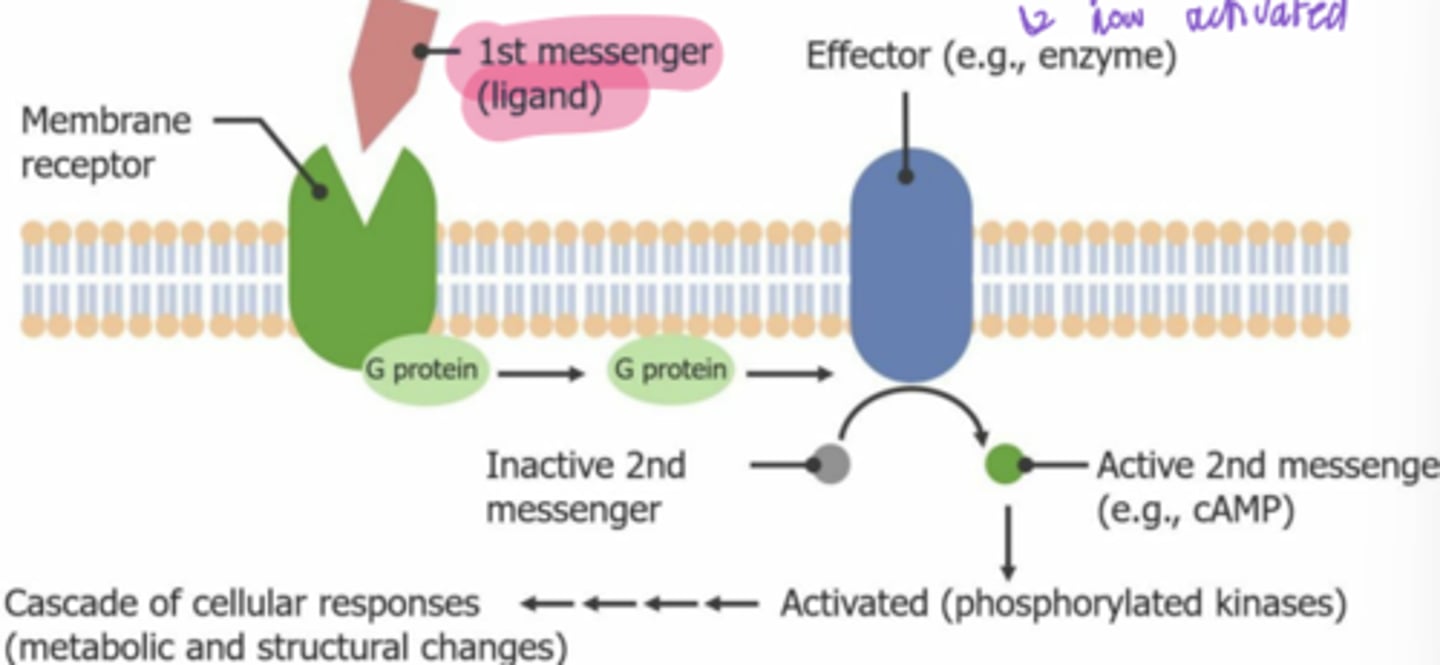
In G-protein coupled receptor GTP is hydrolyzed to GDP and ?
inactivates the G protein
Intracellular receptors is also called? found?
- Also called nuclear receptors
• NOT cell surface/plasma membrane associated
• Found in the cytoplasm (inside the cell)
• Upon binding to ligand, trans-locates to the nucleus as receptor/ligand complex
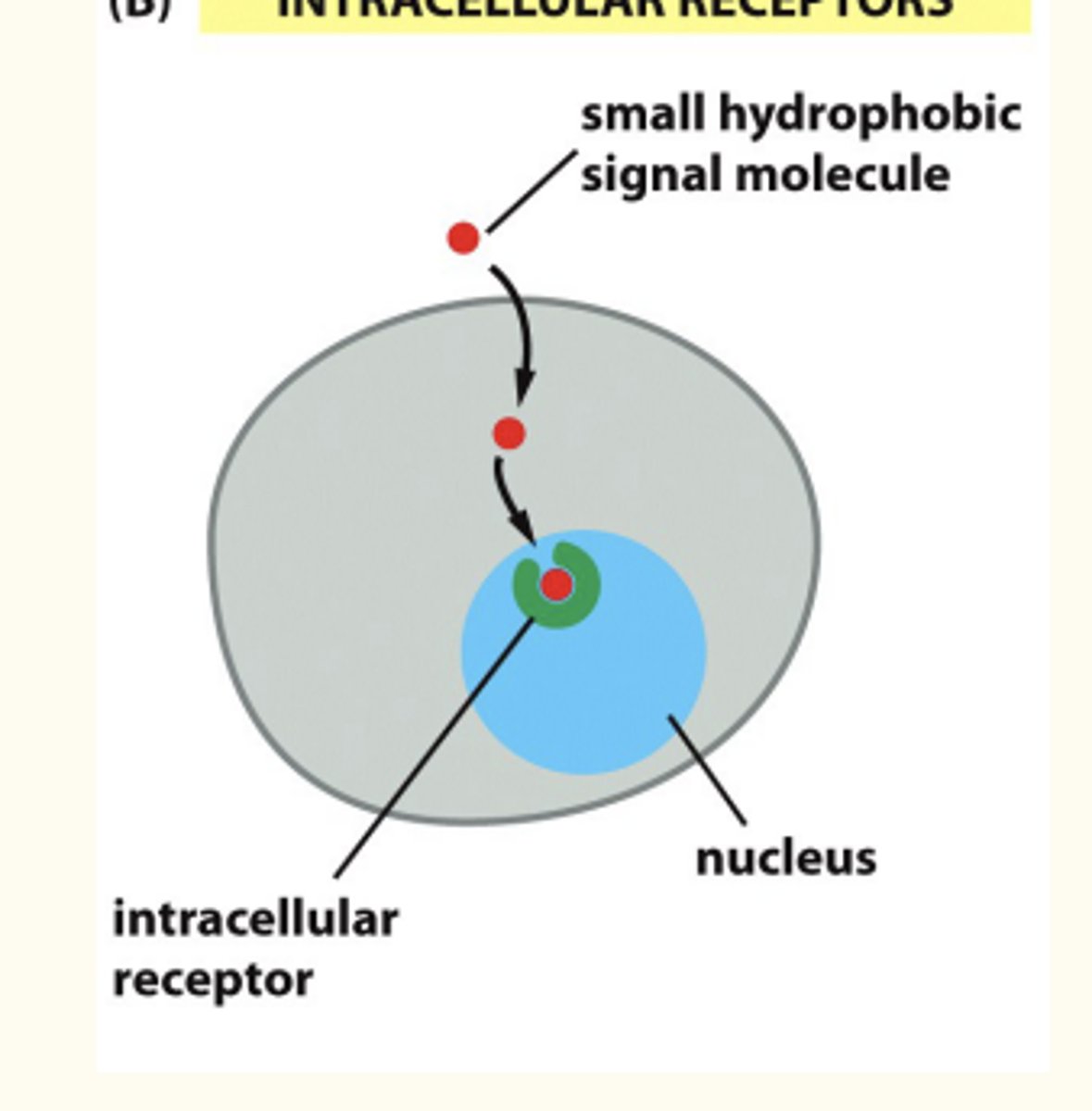
Intracellular hormone receptors
- steroid hormones
Hydrophobic lipid molecules that can pass through the plasma membrane of a cell unaided
• Examples: cortisol, estrogen, testosterone
Receptors for steroid hormones are found in the?
cytoplasm of a cell, NOT on the cell surface
Intracellular hormone receptors they translocate to the?
- to the nucleus when bound by ligand
Intracellular hormone receptors
- in the nucleus, they directly bind to the?
DNA and activate target genes